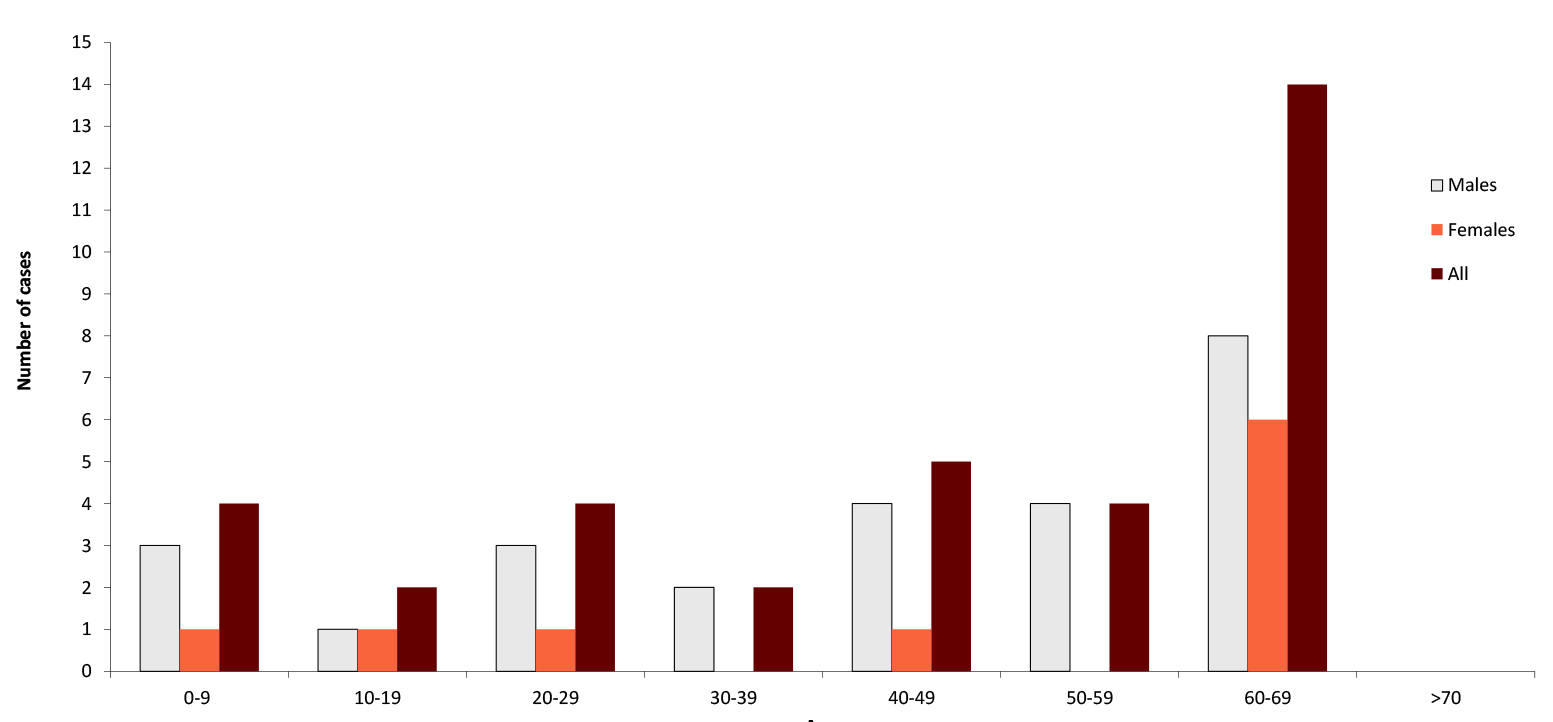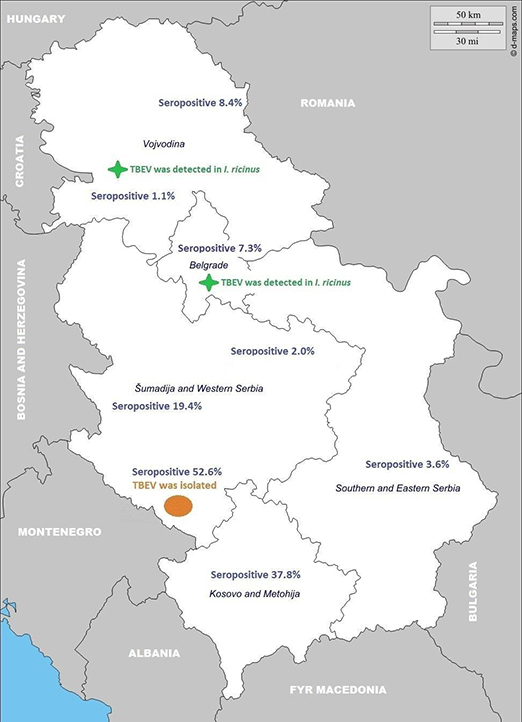Vladimir Petrović, Elizabeta Ristanović and Aleksandar Potkonjak
E-CDC risk status: endemic
(no new data available as of May 2023)
History and current situation
Tick-borne encephalitis virus (TBEV) was first isolated in the former Yugoslavia in 1953 from the blood of infected human patients in Slovenia.1 The virus was isolated from ticks in 1954, also in Slovenia.2 Thereafter a number of tick-borne encephalitis (TBE) foci were registered in the western part of the country, while in the Republic of Serbia such foci were not registered. In the period following 1969, no new infections with TBEV could be confirmed in the Republic of Serbia through the routine serological testing of samples from more than 1,000 patients with clinical signs of meningitis and encephalitis, as conducted in laboratories of the Institute of Immunobiology and Virology “Torlak” in Belgrade.3
In the period from 1962 to 1969, a total of 1,726 serum samples collected from healthy individuals in the Republic of Serbia were tested by hemagglutination inhibition for the presence of antibodies to TBEV and 1.1%–52.6% were positive. The highest percentage of seropositive persons was registered in the region of Sandžak-Raška (Novi Pazar and its surroundings: 52.6%) in the province of Kosovo (37.8%) and in Western Serbia (19.4%). In the area of Banat in the Province Vojvodina antibodies were found in 8.4% of tested sera, while in the territory of Belgrade city the seropositivity rate was 7.3%. In Eastern Serbia (Zaječar and surroundings) – 3.6% samples were seroreactive, 2.0% in Central Serbia and 1.1% in the Srem area in Vojvodina. These results clearly document – along with the isolation of the TBEV (Western subtype) from ixodid ticks from the area of Pešter, Sandžak-Raška in 1972 – the existence of TBEV-hot spots, i.e. active foci of tick-borne encephalitis in the Republic of Serbia.4
Overview of TBE in Serbia
In the Republic of Serbia, TBE is subject to mandatory reporting under the 2004 law for protecting the population from infectious diseases. In that year, a single case of TBE disease was recorded by the Institute of Public Health of Serbia, followed by 6 cases in 2005 and 1 case in 2006.5 In 2012, the Institute of Public Health of Serbia reported a total of 4 cases of TBE, while in 2013 and 2014, no cases of the disease were registered. In 2015, in central Serbia 4 cases of disease were registered; all cases were males and more than 45 years old.6–10
In the last three years, 19 new cases of TBE disease were officially reported to the Institute of Public Health of Serbia. In 2016, in central Serbia (Belgrade region) 1 case of TBE disease was registered (male, age distribution group 40–49 years) and 5 cases of TBE were registered in 2017 (all cases in central Serbia (Belgrade region-3 cases and Podunavlje District-2 cases). All cases were males and more than 20 years old. The largest number of TBE cases (13) was registered in 2018 in central Serbia (Belgrade region: 4 cases; Podunavlje District: 4 cases). Six of these cases were males and 7 cases were females, 1 in the 20–29 years age group, 3 cases in the 40–49 years group, 1 case in the 50–59 year group and 8 cases were older than 60 years.11–13
From January 1, 2014 until October 31, 2015, serum samples from 200 animals (40 dogs, 20 horses, 40 wild boars, 40 cattle, 40 roe deer, and 20 goats) were collected. All serum samples were tested using commercial all-species ELISA kits (Progen Biotechnik, Germany). Anti-TBEV IgG antibodies were found in 7 dogs (17.5%), 1 horse (5%), 5 wild boars (12.5%), 1 cow (2.5%), and 1 roe deer (2.5%). None of the goats tested were positive for anti-TBEV IgG antibodies.11
At the same time, PCR and sequencing confirmed the presence of the Western subtype of TBEV (TBEV-EU) in Ixodes ricinus ticks, detected in 1 of the 50 (2.0%) I. ricinus ticks in Vojvodina province (Fruška Gora mountain) and in 30 of the 450 (6.6%) I. ricinus ticks in the vicinity of Belgrade (Manastirska šuma, Rakovica).14 In 2017, 1 case of TBE disease in horses with acute neurological symptoms was PCR confirmed in Branicevo District.15
Serbia is “endemic” as several human cases have been reported with seasonal recurrences and the presence of TBEV in I. ricinus ticks and/or animals.
| Table 1: Virus, vector, transmission of TBE in Serbia | |
|---|---|
| Viral subtypes, distribution | Presence of Western subtype of TBEV was detected in the regions of Vojvodina province, Belgrade, and Pešter4,14 |
| Reservoir animals | Seropositive species of animals: dogs, horses, wild boars, cattle, and roe deer14 |
| Infected tick species (%) | I. ricinus; 2% and 6.6% at the two different localities14 |
| Dairy product transmission | Not documented |
| Table 2: TBE reporting and vaccine prevention in Serbia | |
|---|---|
| Mandatory TBE reporting | Since 2004, under the Law on Protection of Population from Infectious Diseases |
| Other TBE-surveillance | Since January 2020, surveillance according to the EU Clinical Case Definition is introduced in all hospitals in Autonomous Province of Vojvodina, as a part of Special Public Health Program. Program is based on software application for Case Definition detection in all departments for infectious diseases. |
| Special clinical features | No information available |
| Available vaccines | No information available |
| Vaccination recommendations and reimbursement | Recommended immunization schedule of persons of a certain age against TBE is introduced from April 1, 2019 as a part of National Immunization Program. Primary series of two or three doses followed by booster after one to three years is recommended. There is no reimbursement. Immunization is to be paid out of pocket. |
| Vaccine uptake by age group/ risk group/ general population | Active immunization is recommended as measure of protection of population in endemic areas and for professionally exposed as well as those exposed during recreational activities in endemic areas. There are no information available on vaccine uptake. |
| Name, address/website of TBE National Reference Center | No information available |
Figure 1: Burden of TBE in Serbia6-13

| Year | Number of Cases | Incidence / 10 5 |
|---|---|---|
| 2004 | 1 | 0.01 |
| 2005 | 6 | 0.08 |
| 2006 | 1 | 0.01 |
| 2012 | 4 | 0.06 |
| 2015 | 4 | 0.06 |
| 2016 | 1 | 0.01 |
| 2017 | 5 | 0.07 |
| 2018 | 13 | 0.19 |
Figure 2: Age and gender distribution of TBE in Serbia6-10

| Age groups (years) | Males | Females | All |
|---|---|---|---|
| 0-9 | 3 | 1 | 4 |
| 10-19 | 1 | 1 | 2 |
| 20-29 | 3 | 1 | 4 |
| 30-39 | 2 | 0 | 2 |
| 40-49 | 4 | 1 | 5 |
| 50-59 | 4 | 0 | 4 |
| 60-69 | 8 | 6 | 14 |
| >70 | 0 | 0 | 0 |
Contact:
Vladimir.petrovic@izjzy.org.rs
Citation:
Petrović V, Ristanović E, Potkonjak A. TBE in Serbia. Chapter 12b. In: Dobler G, Erber W, Bröker M, Schmitt HJ, eds. The TBE Book. 6th ed. Singapore: Global Health Press;2023. doi:10.33442/26613980_12b28-6
References
- Vesenjak-Zmijanac J, Bedjanič M, Rus S, Kmet J. Virus meningo-encephalitis in Slovenia: 3. Isolation of the causative agent. Bulletin of the World Health Organization. 1955;12(4):513-20.
- Likar M, Kmet J. Virus meningoencephalitis in Slovenia: 4.Isolation of the virus from the ticks Ixodes ricinus. Bulletin of the World Health Organization. 1956;15(1-2):275-9.
- Borđoški M, Stojković L, Polak D, et al. Etiologija i epidemiologija akutnih virusnih oboljenja nervnog sistema. Srpski arhiv za celokupno lekarstvo. 1969;97(5):531- 47.
- Bordjoski M, Gligic A, Boskovic R. Arbovirus infections in Serbia. Vojnosanitetski pregled. 1972;29(4):173-5.
- Amicizia D, Domnich A, Panatto D, et al. Epidemiology of tick- borne encephalitis (TBE) in Europe and its prevention by available vaccines. Hum Vaccin Immunother. 2013;9(5):1163- 71.
- Institute of Public Health of Serbia. Report on infectious disease in Serbia for 2004, Belgrade, Serbia. Accessed January 9, 2016. Available at: http://www.batut.org.rs/index.php? category_id=140
- Institute of Public Health of Serbia. Report on infectious disease in Serbia for 2005, Belgrade, Serbia. Accessed January 9, 2016. Available at: http://www.batut.org.rs/index.php? category_id=140
- Institute of Public Health of Serbia. Report on infectious disease in Serbia for 2006, Belgrade, Serbia. Accessed January 9, 2016. Available at: http://www.batut.org.rs/index.php? category_id=140
- Institute of Public Health of Serbia. Report on infectious disease in Serbia for 2012, Belgrade, Serbia. Accessed January 9, 2016. Available at: http://www.batut.org.rs/index.php? category_id=140
- Institute of Public Health of Serbia. Report on infectious disease in Serbia for 2015, Belgrade, Serbia. Accessed January 9, 2016. Available at: http://www.batut.org.rs/index.php? category_id=140
- Institute of Public Health of Serbia. Report on infectious disease in Serbia for 2016, Belgrade, Serbia. Accessed January 28, 2020. Available at: http://www.batut.org.rs/download/izvestaji/zarazneBolestiGodisnjiIzvestaj2016.pdf
- Institute of Public Health of Serbia. Report on infectious disease in Serbia for 2017, Belgrade, Serbia. Accessed January 28, 2020. Available at: http://www.batut.org.rs/download/izvestaji/Godisnji%20izvestaj%20zarazne%20bolesti%202017.pdf
- Institute of Public Health of Serbia. Report on infectious disease in Serbia for 2018, Belgrade, Serbia. Accessed January 28, 2020. Available at: http://www.batut.org.rs/download/izvestaji/GodisnjiIzvestajOZaraznimBolestima2018.pdf
- Potkonjak A, Petrović T, Ristanović E, Lalić I, Vračar V, Savić S, Turkulov V, Čanak G, Milošević V, Vidanović D and others. Molecular Detection and Serological Evidence of Tick-Borne Encephalitis Virus in Serbia. Vector Borne Zoonotic Dis. 2017;17(12):813-820.
- Živojinović M, Stokić Nikolić S, Dobrosavljević I, Lazić M., Radojičić S., Stojanović M, Veljović Lj, Milićević V. Tick-Borne encephalitis in Serbia. Proceedings of 28. Serbian Veterinarians’ Conference. 2017; Zlatibor, Serbia:109-113 (In Serbian)
